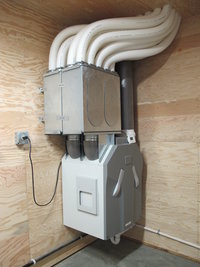
How a Heat Recovery Ventilation System Operates
12/24/2014
The heat recovery ventilation system consists of the central heat recovery ventilation unit and the air distribution system to the individual rooms. Via the air ducts, the used air (extract air) is discharged and fresh air (supply air) is supplied.
An external air intake provides fresh air for the ventilation unit. Depending on the design, the outside air reaches the heat recovery ventilation unit directly or via an optional ground heat exchanger. A ground heat exchanger is an underground pipe system which transports the fresh air from an external intake box to the ventilation system. The temperature of the ground enables the pre-warming of the fresh air to approximately 0°C or 32°F during the cold season, and during the summer pre-cooling to approximately 22°C/72°F. Without a ground heat exchanger, a defrost pre-heater (electric or brine) is necessary, in order to protect the heat exchanger from the too cold fresh air.
Subsequently, the outside air is filtered in the ventilation unit and is then transported through the heat exchanger. Here, the heat of the warm extract air (approximately 20°C/68°F) is used to raise the temperature of the cold fresh incoming air to a comfortable temperature level. This process is called heat recovery. The better the heat recovery rate of the ventilation unit, the higher the energy-efficiency of the ventilation system.
In doing so, fresh air and extract air are flowing in separate systems and are not mixed. Two separate fans ensure air transport. The ventilation unit guides the fresh air into the individual rooms via supply air ducts. The used air is transported to the ventilation unit via extraction air ducts. It is filtered and then used by the heat exchanger to heat up the fresh air. Subsequently, it reaches the outside via the exhaust air duct. Thus, the air distribution system is divided into supply air and extract air ducts. Silencers prevent the transport of the machine noise through the ventilation ducts. Necessary components are also the distribution systems, air passage casings, as well as filters, outlets, and valves.
In the case of Zehnder’s ventilation systems, the air is controlled via a control panel, which is often located centrally in the building. It can be adjusted according to the different usage patterns. It also indicates when the required filter checks or replacements are due.
The main components of the whole house comfort ventilation system are:
• Outside air inlet with filter, if necessary with a ground heat exchanger or defroster
elements
• Outside air ducts
• Ventilation unit with heat recovery
• Device silencer
• Supply air ducts
• Air passages with supply grille or supply
air valves
• Extract filter elements
• Extract air ducts
• Exhaust air ducts
• Control with an external control panel
To learn more about how a heat recovery ventilation system operates, click here to go to the Zehnder Academy.
